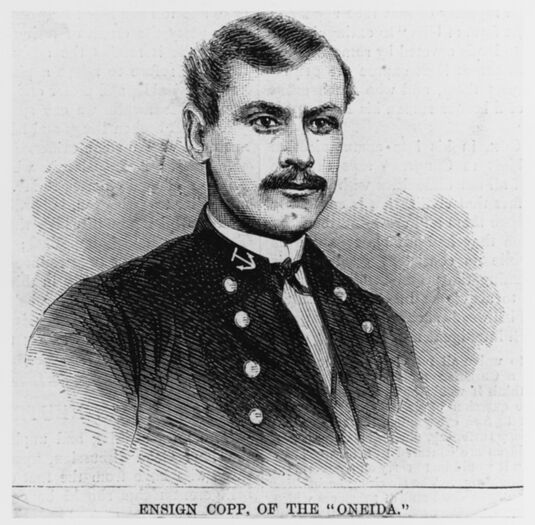CHARLES A. COPP, ENS, USN
Charles Copp '68
Charles Albert Copp was admitted to the Naval Academy from Brooklyn, New York on November 5, 1864 at age 17 years 3 months.
He was admitted as "Enlisted boy".
Loss
Charles was lost on January 24, 1870 when USS Oneida was sunk following a collision with a British merchant steamer while departing Yokohama harbor, Japan. One hundred twenty-four other officers and men were also lost.
A detailed account of the event is available here.
Other Information
From the New York Herald on March 15, 1870:
Ensign Charles A. Copp, who was lost on the Oneida, was born in Troy, N. ¥., July 26, 1827, and came from an old and respected New Hampshire family. A stubborn will and great physical force Well tempered by a Kindly disposition, made him a leader among his companions from boyhood. During his early school days he deposited in the savings bank a good sum of money obtained by selling newspapers. Though constantly with the roughest newsboys he retains a remarkable purity of character, and never in his life resorted to alcoholic stimulants or even used tobacco in any form. At fourteen he was admitted to the Troy High School from the grammar department of Professor John W. Cole, a superior teacher; out, preferring an active life, he gladly accepted in the following year a clerkship in New York. Here he made the acquaintance of a paymaster, Who promised him the place of purser’s steward; and believing he could aid his country as well in that position as in any other he entered the United States Navy in September, 1863, as an enlisted boy. Through some mistake he was transferred to the wrong vessel; but, making the best of it, he passed a year on the blockade, participating in the siege of Charleston and acquiring a practical knowledge of modern naval warfare. An appointment to the academy was offered him while on the Monadnock which he was inclined to refuse, fearing he was too rusty in his studies to pass the required examination. His officers, who admired his manly ways and seamanlike qualities, urged him to accept; and one of them, Lieutenant Commander Joseph N. Miller, whom he often mentioned gratefully, even threatened, if he refused to reduce him from a petty office to which he had been promoted. He was complimented at Newport on his examination in mathematics and immediately re-entering the school become champion for his younger and weaker fellow "plebes" in their usual encounters with upperclassmen. He was one of the movers in an organized defense, and for some time was president of his class. During his course he studied just enough to pass the several examinations, giving his attention to the practical branches and excelling in all manly sports. He was a leading member of the ball and boat clubs, was a splendid swordsman and the best boxer at the Academy. He graduated with his class in June, 1868, and in October following was ordered to report to Admiral Rowan of the Asiatic squadron. He served Of the flagship Delaware until October, 1869, when he was transferred to the Idaho, and came near death when that vessel was caught by a typhoon and broken almost in two. He was on his way home for examination for promotion when Captain Arthur W. Eyre, of the Bombay, so cruelly put an end to his brief career.
Report speaks well of young Copp as an officer. His magnificent physique gave him a commanding presence and his noble bearing won the respect of all with whom he came in contact. He had rare executive ability and a tone of command that caused his every order to be instantly obeyed. He was a genial companion, a sympathetic friend, a loving, devoted son and brother. Of his heroic death the reader bas been made acquainted.
From the Marysville Daily Appeal, 24 March 1870, via the records of the US Naval Academy Alumni Association:
The Officers of the Oneida. Below we give sketches of some of the officers who perished in the ill-fated Oneida:
MIDSHIPMAN A. C. COPP was a resident of Brooklyn, and entered the service as an enlisted boy. He was subsequently appointed to the Naval Academy because of his fine seamanlike qualities, and was a leader in that institution in he athletic sports of his class, maintaining his pre eminence against most all comers. He was excellent with the oar, superior at base-ball, and was a good fencer. His powerful physique made him soldierly in appearance and attested his worth as a national guardian.
His father Amasa was a clerk and weighmaster.
He has a memory marker in Washington, D.C., and is listed on the USS Oneida memorial at the Yokohama Foreign General Cemetery in Japan.
Career
From the Naval History and Heritage Command:
Acting Midshipman, 25 February, 1863. Graduated 6 June, 1867. Ensign, 18 December, 1868. Lost on board the Oneida, 24 January, 1870.
Related Articles
Edward Williams '53, William Stewart '61, John Phelan '66, Charles Brown '67, James Cowie '67, James Hull '68, William Uhler '68, George Bower '68, and George Adams '68 were also lost aboard Oneida.
The "Register of Commissioned and Warrant Officers of the United States Navy and Marine Corps" was published annually from 1815 through at least the 1970s; it provided rank, command or station, and occasionally billet until the beginning of World War II when command/station was no longer included. Scanned copies were reviewed and data entered from the mid-1840s through 1922, when more-frequent Navy Directories were available.
The Navy Directory was a publication that provided information on the command, billet, and rank of every active and retired naval officer. Single editions have been found online from January 1915 and March 1918, and then from three to six editions per year from 1923 through 1940; the final edition is from April 1941.
The entries in both series of documents are sometimes cryptic and confusing. They are often inconsistent, even within an edition, with the name of commands; this is especially true for aviation squadrons in the 1920s and early 1930s.
Alumni listed at the same command may or may not have had significant interactions; they could have shared a stateroom or workspace, stood many hours of watch together… or, especially at the larger commands, they might not have known each other at all. The information provides the opportunity to draw connections that are otherwise invisible, though, and gives a fuller view of the professional experiences of these alumni in Memorial Hall.
July 1868
January 1869

The "category" links below lead to lists of related Honorees; use them to explore further the service and sacrifice of alumni in Memorial Hall.
